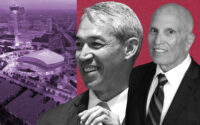Office tenants are meeting their employees where they are, according to emerging trends in the Dallas-Fort Worth market, which show strong activity in the suburbs as well as firms exiting central business districts.
Dallas had its best first quarter since 2019, and much of that activity came from top-tier office properties in suburban submarkets like Far North Dallas and Las Colinas, according to JLL.
Meanwhile, Fort Worth posted 94,118 square feet of positive net absorption in the first quarter, marking the first time since 2019 that more space was leased than vacated.
Among the biggest leases in the Dallas suburbs was Simpson Strong-Tie Company’s 38,000-square-foot lease at Granite Properties’ Granite Park 6 in Plano. The biggest in the Fort Worth suburbs was the United Football League’s 111,000 square feet for a headquarters at Fort Capital’s Ballpark Circle, at 1401 Nolan Ryan Expressway in Arlington.
Just as financial institutions are moving away from downtown Dallas to Uptown, creating a foundation for the burgeoning Y’all Street, banks are also moving away from downtown Fort Worth.
JPMorgan Chase is the latest. The bank plans to move from downtown to a building being developed in the Fort Worth Cultural District by billionaire John Goff’s Crescent Real Estate. Chase will take three floors, about 130,000 square feet, of the 170,000-square-foot building at 420 Throckmorton Street. Construction of the building was expected to begin this week and wrap up in 2027.
Wells Fargo will jump ship this year from its namesake building at 201 Main Street to another new mixed-use office tower in Clearfork. Charles Schwab moved its headquarters to Westlake four years ago, and BBVA also vacated a portion of its downtown space in recent years.
Morgan Stanley expanded to a second location at the Crescent East office building last July but maintains its office downtown at 201 Main Street.
“Something of a financial district is forming just adjacent to the Fort Worth Cultural District,” JPMorgan’s Dallas region chair Elaine Agather told Bloomberg.
Here’s what else happened in Texas real estate this week.
- Embattled Austin real estate investor Nate Paul avoided prison time in a plea deal with the Department of Justice this week. He pleaded guilty to one count of making false statements to a lending institution, and prosecutors dropped 11 other charges. He was sentenced to four months of home confinement, five years of supervised release and a $1 million fine.
- A couple of major cities in Texas got involved with real estate this week. Dallas is considering the purchase of the former Dallas Morning News building in downtown, which is in the path of its planned multi-billion dollar convention center plans. The city reportedly is willing to pay $52 million for the building at 508 Young Street, which would be an 86 percent premium over what Ray Washburne paid for it in 2019.
- The city of Austin has a deal to buy a 207,000-square-foot office building at 3300 North I-35 for $26.2 million, or $127 per square foot. The city isn’t making rapid changes in regards to return-to-office. Instead, it wants to move employees from a potentially more valuable building, at 505 Barton Springs Road, and possibly put that up for sale or lease.
- A couple of deals this week showed that real estate players are still betting on Texas’ oversupplied multifamily markets. Atlanta-based RangeWater Real Estate is partnering with Meridian Group subsidiary TMGRI on a 240-unit apartment complex in South Austin. And Texas Group secured $13.9 million in fresh financing for Sandrock Gardens, a 69-unit single-family rental home community in Houston.
- In the Texas Hill Country, groundwater and wastewater concerns are often at the forefront of development discussions. In the Austin suburb Dripping Springs, a long-running wastewater battle that stymied commercial development ended with a judge’s ruling. And a developer, whose proposal for an amphitheater near Bee Cave drew widespread criticism, has pivoted to a luxury mixed-use plan.
—Rachel Stone
Read more



